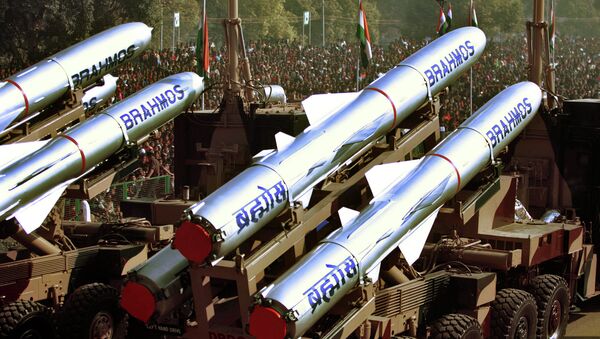New Delhi (Sputnik) — Indian defense scientists successfully validated the life extension test of supersonic cruise missile BrahMos on Monday morning from the Integrated Test Range (ITR) in Chandipur, Odisha. The test was highly successful despite the extremely strong winds and heavy rain at sea, according to sources.
With this, the lifespan of one of the world's deadliest missiles can be increased to 15 years, from the present lifespan of 10 years. This will benefit the armed forces to maintain inventory for more a economical and longer duration.
READ MORE: BrahMos Supersonic Cruise Missiles Receive Cost-Effective Indian-Made Seeker
"The precision strike missile flew in its designated trajectory and the key components functioned perfectly," a government official said.
#BrahMos supersonic cruise missile test fired from Odhisa coast. This was the third life-extension test of the BrahMos cruise missile. Congratulations!@DRDO_India @isro pic.twitter.com/WAouPqNBhE
— Dr Rutvij Patel (@DrRutvij) July 16, 2018
The scientists have also started work on an advanced version of the missile which can target an enemy behind mountain ranges.
"Earlier, we used to go for a simple trajectory or a cruise trajectory against a ship. We said, why not make it a vertical dive trajectory and we came out with a vertical dive. Now we are working for a near vertical trajectory that would be very effective against the enemy hidden behind mountains. Not only hidden but hidden in bunkers behind the mountains," Sudhir Kumar Mishra, CEO of BrahMos, said earlier this month while speaking on the sidelines of a function organized by L&T Defence at Ranoli in Gujarat.
READ MORE: Many States Interested in BrahMos as Talks Are Underway — Indian Defense Chief
BrahMos variants can be launched from land, air, sea and underwater. While the naval and land attack versions of the missile are already in service, the Hindustan Aeronautics Limited has started the work to integrate the air-launched versions of the missile into 40 Su-30 MKI fighter jets.
Currently, BrahMos travels at a speed of Mach 2.8 or 2.8 times the speed of sound. The manufacturers aim to increase the speed to Mach 7 in the next few years.



